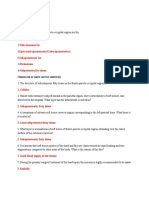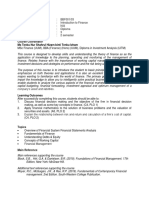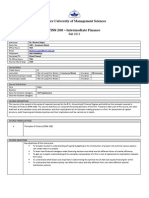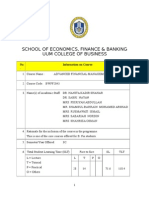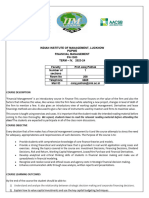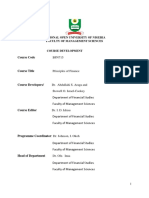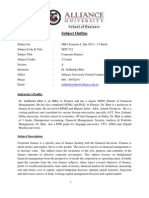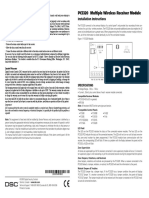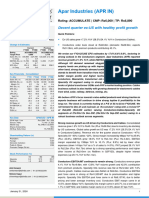Managerial Finance SYLLABUS
Managerial Finance SYLLABUS
Uploaded by
ealselwiCopyright:
Available Formats
Managerial Finance SYLLABUS
Managerial Finance SYLLABUS
Uploaded by
ealselwiOriginal Description:
Original Title
Copyright
Available Formats
Share this document
Did you find this document useful?
Is this content inappropriate?
Copyright:
Available Formats
Managerial Finance SYLLABUS
Managerial Finance SYLLABUS
Uploaded by
ealselwiCopyright:
Available Formats
Course Outline
Welcoming Note
Welcome to BMMF 5103 : Managerial Finance.
Finance is an exciting yet interesting, challenging and ever-changing discipline. With the emergence of
liberations and globalisation, new technology and innovations have brought a profound impact on the
financial practices and markets. Managers are concerned with acquiring, financing and managing the
business assets under these changes. Thus knowledge on managerial finance is essential for managers
to perform their financial duties.
Program Masters In Business Administration
Module
Managerial Finance
Code BMMF 5103
Status Core Course
Level Master
Credit Hours 3 Credits (120 hours of learning in a semester)
Pre-requist None
Evaluation
60% Coursework
40% Final Exam
Lecturer Assoc. Prof. Loo Sin Chun
Semester
Taught
May 2004
Objectives The course is designed to provide an overview of the basic concepts and
principles of financial management, with particular emphasis on risks, rates
of return, and valuation.
Synopsis The course will focus on theories, concepts, and principles as opposed to
institutional materials, although some institutional background is also
presented.
Since this course is required of all MBA students, and not just finance
majors, a great deal of materials will be covered, but in-depth treatments
will be left to follow-on courses.
Module
Structure
Title / Topics
Total Learning
Hours
UNIT 1 Overview of Financial Management
Financial Objective of Firms
40
The Financial Environment: Markets,
Institutions and Interest Rates
Risk and Return:
Measuring risk and return
Risk-return trade-off
Financial Statement Analysis
UNIT 2 Time Value of Money
Compounding & Discounting
Present & Future Value
Annuity
Valuation of Assets
General Valuation Model
Bond Valuation
Stock Valuation
Capital Budgeting
Net Present Value (NPV)
Profitability Index (PI)
Internal Rate of Return (IRR)
Modified Internal Rate of Return
(MIRR)
Conflict between NPV & IRR
Cash Flow Estimation and Other Topics in
Capital Budgeting
Risk Analysis in Capital Budgeting
The Cost of Capital
Component cost of debt and equity
Weighted average cost of capital
40
UNIT 3 Capital Structure Decisions: The Basics
Traditional View of Capital Structure
Alternative view of Capital Structure
Dividend Decisions: The Basics
Long-Term Financing Decisions
Long-Term Loans
Preference Shares
Ordinary Shares
Working Capiral Management (WCM)
Current Asset Management
Current Liability Management
Risk-Return Trade-off in WCM
40
TOTAL 120
Reference Compulsory Brigham, E.F., Gapenski, L.C. and Ehrhardt,
M.C.(2002), Financial Management: Theory and
Practice, Harcourt College Publishers, 10th Edition.
Additional Copeland, T.E. and Weston, J.F. (2003), Financial Theory
and Corporate Policy, 3
rd
Edition, Addison Wesley.
Van Horne, J.C.(2002), Financial Management and Policy,
12th Edition, Prentice-Hall, 11e.
Gitman, L.(1997), Managerial Finance, 8th edition. Addison-
Wesley.
Brealey, R.A. and Myers, S.C.(2003), Principles of
Corporate Finance, McGraw-Hill International, 5e.
Bank Negara Malaysia (1999), The Central Bank and the
Financial System in Malaysia - A Decade of Change
1989-1999, Bank Negara Malaysia.
Untitled document
You might also like
- Copy1 TOPANAT EXAM MCQ Nee RevisedDocument125 pagesCopy1 TOPANAT EXAM MCQ Nee Revisedkapil pancholiNo ratings yet
- Courseoutline FMIIDocument3 pagesCourseoutline FMIIfdsfsfNo ratings yet
- Lesson Plan - Fin430 Semester March 2023Document3 pagesLesson Plan - Fin430 Semester March 2023Nur Nadirah HamidiNo ratings yet
- Course Outline All in OneDocument50 pagesCourse Outline All in OneMillionNo ratings yet
- University of Gujrat Faculty of Management and Administrative SciencesDocument4 pagesUniversity of Gujrat Faculty of Management and Administrative SciencesObaidUllah ManzarNo ratings yet
- Business Finance OutlineDocument4 pagesBusiness Finance OutlineSalahuddin SultanNo ratings yet
- FM-I Course OutlineDocument5 pagesFM-I Course OutlineShaggYNo ratings yet
- Financial Management-MBA 622 Course Outline (MBA) March 2021Document4 pagesFinancial Management-MBA 622 Course Outline (MBA) March 2021Nebiyu Samuel100% (1)
- Jaipuria Institute of Management, Lucknow Post Graduate Diploma in Management THIRD TRIMESTER (2013-2014)Document6 pagesJaipuria Institute of Management, Lucknow Post Graduate Diploma in Management THIRD TRIMESTER (2013-2014)saah007No ratings yet
- Advanced Financial Management Course OutlineDocument3 pagesAdvanced Financial Management Course OutlineMan TK100% (2)
- Financial Management SyllabusDocument2 pagesFinancial Management SyllabusEric Dela CruzNo ratings yet
- Financial ManagementDocument3 pagesFinancial ManagementwunnawinchesterNo ratings yet
- Masters of Business Administration: (Financial Strategy and Policy)Document12 pagesMasters of Business Administration: (Financial Strategy and Policy)Tanveer AhmedNo ratings yet
- Module Title: Module Code:: Module Specifications: Schools of Business & Management & Information TechnologyDocument3 pagesModule Title: Module Code:: Module Specifications: Schools of Business & Management & Information TechnologyJacob DyNo ratings yet
- Syllabus2014 2015 PDFDocument9 pagesSyllabus2014 2015 PDFartolas21No ratings yet
- BBF001 - 03 Introduction To FinanceDocument2 pagesBBF001 - 03 Introduction To FinanceldlNo ratings yet
- Dfi 501 Course OutlineDocument3 pagesDfi 501 Course OutlineblackshizoNo ratings yet
- FINN 200 - Intermediate Finance-Bushra NaqviDocument4 pagesFINN 200 - Intermediate Finance-Bushra NaqviazizlumsNo ratings yet
- Financial Management 1Document5 pagesFinancial Management 1Nishant ShuklaNo ratings yet
- School of Economics, Finance & Banking Uum College of BusinessDocument9 pagesSchool of Economics, Finance & Banking Uum College of BusinessSeekengNo ratings yet
- FM - Course PlanDocument3 pagesFM - Course PlanAsfawosen DingamaNo ratings yet
- MSM 619 Module Outline ....Document3 pagesMSM 619 Module Outline ....ElizabethNo ratings yet
- Mba DescripDocument24 pagesMba DescripsikandarbatchaNo ratings yet
- 511 Ac & Finance For ManagersDocument3 pages511 Ac & Finance For ManagersYonasNo ratings yet
- Course OutlineDocument2 pagesCourse OutlineJohn Carlos WeeNo ratings yet
- Financial MGTDocument1 pageFinancial MGTBaimwera BenNo ratings yet
- H11FMDocument9 pagesH11FMsimlaislamNo ratings yet
- Financial Management 2 Course Outline 2021Document7 pagesFinancial Management 2 Course Outline 2021Shannan RichardsNo ratings yet
- Syllabus FIN420Document3 pagesSyllabus FIN420Sazali HanemNo ratings yet
- Course SyllabusDocument2 pagesCourse SyllabusManpreet ToorNo ratings yet
- Couresot LineDocument2 pagesCouresot LineSeifu BekeleNo ratings yet
- Financial Management Course OutlineDocument4 pagesFinancial Management Course OutlineRatul HasanNo ratings yet
- Business FinanceDocument3 pagesBusiness FinanceIqtidar Hussain Ghizer CampusNo ratings yet
- Post Graduate Programme in Management (PGP) AY: 2020-21 Term: Ii Title of The Course: Finance - I Credits: 3Document6 pagesPost Graduate Programme in Management (PGP) AY: 2020-21 Term: Ii Title of The Course: Finance - I Credits: 3Rohit PanditNo ratings yet
- Assistant Professor, Department of Business Administration, & Head, Dept. of Tourism & Hospitality Management, VUBDocument2 pagesAssistant Professor, Department of Business Administration, & Head, Dept. of Tourism & Hospitality Management, VUBAlaminTanverNo ratings yet
- New-Silibus Bwff2013 Mqa-StudentDocument8 pagesNew-Silibus Bwff2013 Mqa-StudentBlack Fish FishNo ratings yet
- FM Pgpwe 2024Document4 pagesFM Pgpwe 2024ANKIT SHARMANo ratings yet
- Scope & Objective of The Course: Analysis of Cost and Key Factors To Optimize ReturnDocument4 pagesScope & Objective of The Course: Analysis of Cost and Key Factors To Optimize ReturnPrabhjeet KalsiNo ratings yet
- BFN715Document244 pagesBFN715Misbah MirzaNo ratings yet
- CF - Section A - DR - Sudhindra BhatDocument5 pagesCF - Section A - DR - Sudhindra BhatAbarna LoganathanNo ratings yet
- Syllabus For Financial ManagementDocument3 pagesSyllabus For Financial ManagementRio DhaniNo ratings yet
- Bank Fin Managem PDFDocument38 pagesBank Fin Managem PDFOdirile MasogoNo ratings yet
- MFRD GuidelinesDocument5 pagesMFRD GuidelinesNguyen Dac ThichNo ratings yet
- Syllabus MK VHW (New Version) 20130211Document5 pagesSyllabus MK VHW (New Version) 20130211RyanSudiroNo ratings yet
- FM108 Prelim HandoutsDocument8 pagesFM108 Prelim HandoutsKarl Dennis TiansayNo ratings yet
- Financial ManagementDocument7 pagesFinancial Managementisamad820No ratings yet
- Course Plan BCom Sem5 Fundamental of Financial ManagementDocument8 pagesCourse Plan BCom Sem5 Fundamental of Financial Managementchowdhurysubham87No ratings yet
- H11FM RebrandDocument9 pagesH11FM Rebrandrajbhandarisamyukta03No ratings yet
- Institute of Management Sciences Bahauddin Zakariya University (Multan) Course Outline: Strategic Financial ManagementDocument4 pagesInstitute of Management Sciences Bahauddin Zakariya University (Multan) Course Outline: Strategic Financial ManagementJarhan AzeemNo ratings yet
- Corporate Finance Course OutlineDocument3 pagesCorporate Finance Course Outlinesarahmuthoni352No ratings yet
- Corporate Finance Course Outline-24Document4 pagesCorporate Finance Course Outline-24neyazimuhammad14No ratings yet
- FIMA 30013 Course Guide AY2023-2024Document3 pagesFIMA 30013 Course Guide AY2023-2024Joem TarogNo ratings yet
- Ncba Course Outline FMDocument4 pagesNcba Course Outline FMmacasinaganne05No ratings yet
- BATA India Working Capital Management Finance Project MbaDocument3 pagesBATA India Working Capital Management Finance Project MbaTaz Uddin100% (1)
- Lesson Plan - Fam & CF - WicDocument2 pagesLesson Plan - Fam & CF - WicNimal Jose KureekattilNo ratings yet
- Course Outline Financial Management-2018-19Document4 pagesCourse Outline Financial Management-2018-19Jayesh MahajanNo ratings yet
- Financial Accounting TheoryDocument8 pagesFinancial Accounting TheoryJustAHumanNo ratings yet
- FIN 9501 MNS MBA Course OutlineDocument8 pagesFIN 9501 MNS MBA Course OutlinekhantabassumanikaNo ratings yet
- Wiley CMAexcel Learning System Exam Review 2017: Part 2, Financial Decision Making (1-year access)From EverandWiley CMAexcel Learning System Exam Review 2017: Part 2, Financial Decision Making (1-year access)No ratings yet
- Fundamentals of Performance Improvement: Optimizing Results through People, Process, and OrganizationsFrom EverandFundamentals of Performance Improvement: Optimizing Results through People, Process, and OrganizationsNo ratings yet
- Autounit: White PaperDocument12 pagesAutounit: White PaperealselwiNo ratings yet
- BMST5103 Assignment Sept 2014Document2 pagesBMST5103 Assignment Sept 2014ealselwiNo ratings yet
- Part 1 Course GuideDocument12 pagesPart 1 Course GuideealselwiNo ratings yet
- Program Masters in Business AdministrationDocument2 pagesProgram Masters in Business AdministrationealselwiNo ratings yet
- Marketing ManagementDocument87 pagesMarketing ManagementZaid Chelsea100% (1)
- Radio Network Dimensioning For GSM/GPRS Supporting Circuit-And Packet-Switched ServicesDocument18 pagesRadio Network Dimensioning For GSM/GPRS Supporting Circuit-And Packet-Switched ServicesealselwiNo ratings yet
- IQ Test PDFDocument15 pagesIQ Test PDFمحمد عبد السيد100% (4)
- Police Analyst: The Art of Filtering Duplicates in ExcelDocument10 pagesPolice Analyst: The Art of Filtering Duplicates in ExcelealselwiNo ratings yet
- Job Order Vs Process Costing: Transparency Master 2-1Document14 pagesJob Order Vs Process Costing: Transparency Master 2-1Patrick VoiceNo ratings yet
- Abruptio PlacentaDocument29 pagesAbruptio PlacentaAudrey DelfinNo ratings yet
- LLM Disseertation FinalDocument120 pagesLLM Disseertation FinalgoswamiphotostatNo ratings yet
- PG MQ Mopup Allotments List College Wise Iccc IndiaDocument24 pagesPG MQ Mopup Allotments List College Wise Iccc Indiadivyajadam12No ratings yet
- Sanitation and Pest Control ProcedureDocument6 pagesSanitation and Pest Control ProcedureEtta Jenee100% (2)
- Rep Vs Heirs of Enrique OribelloDocument5 pagesRep Vs Heirs of Enrique OribelloAnonymous himZBVQcoNo ratings yet
- Faktor Budaya Yang Mempengaruhi Perilaku Bersih Di Pesantren Kajian Terhadap Kultur Pesantren Yang Mempengaruhi Tingkat Kesehatan SantriDocument14 pagesFaktor Budaya Yang Mempengaruhi Perilaku Bersih Di Pesantren Kajian Terhadap Kultur Pesantren Yang Mempengaruhi Tingkat Kesehatan SantriKang FauzNo ratings yet
- Stat Report Andhra Pradesh2014Document492 pagesStat Report Andhra Pradesh2014kdineshcNo ratings yet
- Pariyerum Perumal On The Caste Reality oDocument4 pagesPariyerum Perumal On The Caste Reality oishraf908No ratings yet
- Conflict Between Ambani BrothersDocument11 pagesConflict Between Ambani Brothersarpita nayakNo ratings yet
- Uganda Contingent Commander Brigadier General Sam Kavuma Concludes One Year Tour of Duty in SomaliaDocument3 pagesUganda Contingent Commander Brigadier General Sam Kavuma Concludes One Year Tour of Duty in SomaliaAMISOM Public Information ServicesNo ratings yet
- JBA Vol 6 No 2 2019Document123 pagesJBA Vol 6 No 2 2019Andres DharmaNo ratings yet
- PC5320 - Manual Instalare PDFDocument2 pagesPC5320 - Manual Instalare PDFDarie SilviuNo ratings yet
- 5 02-09-2022 Sale On Approval FTDocument4 pages5 02-09-2022 Sale On Approval FTShweta BhadauriaNo ratings yet
- Apartment Ownership Act, 1994Document3 pagesApartment Ownership Act, 1994Arockia AmalanNo ratings yet
- Werner Von Siemens en PDFDocument4 pagesWerner Von Siemens en PDFsysvNo ratings yet
- 20242005571640vacancy Announcement Tutorial Assistant OutDocument7 pages20242005571640vacancy Announcement Tutorial Assistant OutAhmed AllyNo ratings yet
- Prabhudas Lilladher Apar Industries Q3DY24 Results ReviewDocument7 pagesPrabhudas Lilladher Apar Industries Q3DY24 Results ReviewvenkyniyerNo ratings yet
- Uts Group 2Document8 pagesUts Group 2che.villaflor28No ratings yet
- Is Religiousness A Form of Variation in Personality, or in Culture, or Neither? Conceptual Issues and Empirical IndicationsDocument8 pagesIs Religiousness A Form of Variation in Personality, or in Culture, or Neither? Conceptual Issues and Empirical IndicationsBien Clay D. ParillaNo ratings yet
- 7 armors of GodDocument75 pages7 armors of Godmatawaransharmaine7No ratings yet
- Strategic Staffing 3rd Edition Phillips Solutions Manual 1Document7 pagesStrategic Staffing 3rd Edition Phillips Solutions Manual 1joan100% (54)
- solution-1725660Document6 pagessolution-1725660sharmamaya917161No ratings yet
- Do-It-Yourself 0. 00. TheyDocument6 pagesDo-It-Yourself 0. 00. TheyAlin NguyenNo ratings yet
- 0806 KS ORKA Indonesia Compro 2019-Web SpreadDocument9 pages0806 KS ORKA Indonesia Compro 2019-Web SpreadPatrisia IndNo ratings yet
- Contemporary Issues in EntrepreneurshipDocument14 pagesContemporary Issues in EntrepreneurshipJonc Lovely MutindaNo ratings yet
- Nautical Slang in Common UsageDocument9 pagesNautical Slang in Common UsageJacketNo ratings yet
- Arabic PPSC PDFDocument2 pagesArabic PPSC PDFSaeed Saeed AhmadNo ratings yet
- Attendance Sheet Data PrivacyDocument11 pagesAttendance Sheet Data PrivacyDivina Grace Rodriguez - LibreaNo ratings yet
- Oec Margin Fee SlipDocument2 pagesOec Margin Fee SliphafizgNo ratings yet

